In a car, there are multiple things that need to work together to ensure a safe and comfortable ride. Some of these systems are more obvious as the difference they make is visible, while some don’t get the same love. We will discuss both and how such systems allow us to safely and comfortably ride. This is a blog about car brakes, safety and control systems. Another big one, people.
Automotive Brakes
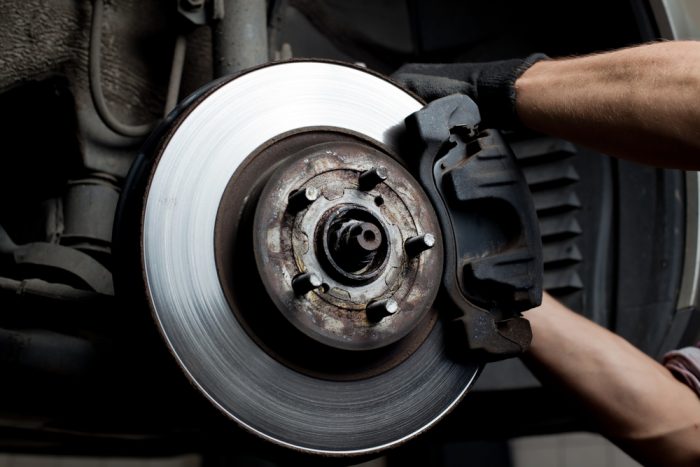
Brakes are one of the most critical components of a car. We should preach to the choir when we say driving a car without brakes invites certain death. With just the press of a pedal or the pulling of a lever, the car comes to a halt. How do brakes work, though? How many types are there, what is the history behind them and what is the future of it? We will discuss everything as we go deeper into the world of brakes.
History Of Brakes
It’s been over a hundred years since the first brakes made a debut. Made of wood and controlled by a lever, these brakes were used to slow down carriages or cars with steel-rimmed wheels. That was a long time ago, though. And with cars back then reaching maximum speeds of 30-35 km/hr, these brakes were good. As technology advanced and cars kept on getting faster, new brakes were also developed to keep up with the speed of the car and the ever-increasing demand for cars on road. This led to multiple different types of brakes, from simple drum brakes to highly advanced automatic brakes.
Before we get into the types of brakes and their working, we must understand the principle behind them.
Principle
This will be a common point in every braking system. The principle used by every brake is friction. Opposing any force is something friction does, but we increase it using brakes. Friction converts kinetic energy into heat energy, thus effectively bringing the car to a stop. Every time of brake will use friction to stop the car, one way or another. Brakes introduce a stationary element and put it in contact with a moving one, thus causing friction.
Even though it’s the same principle, there are multiple brakes suitable for different scenarios. Onto the types of brakes!
Types Of Automotive Brakes
The brakes that we will cover are as follows.
- Mechanical drum brakes
- Disc brakes
We will also discuss various methods to boost a braking system’s efficiency and help the driver in the control section of the blog.
In the type of brakes, we will discuss the history, construction, and working of the brake and its advantages and disadvantages. The details will be as in-depth as possible and easy to follow.
Mechanical Drum Brakes
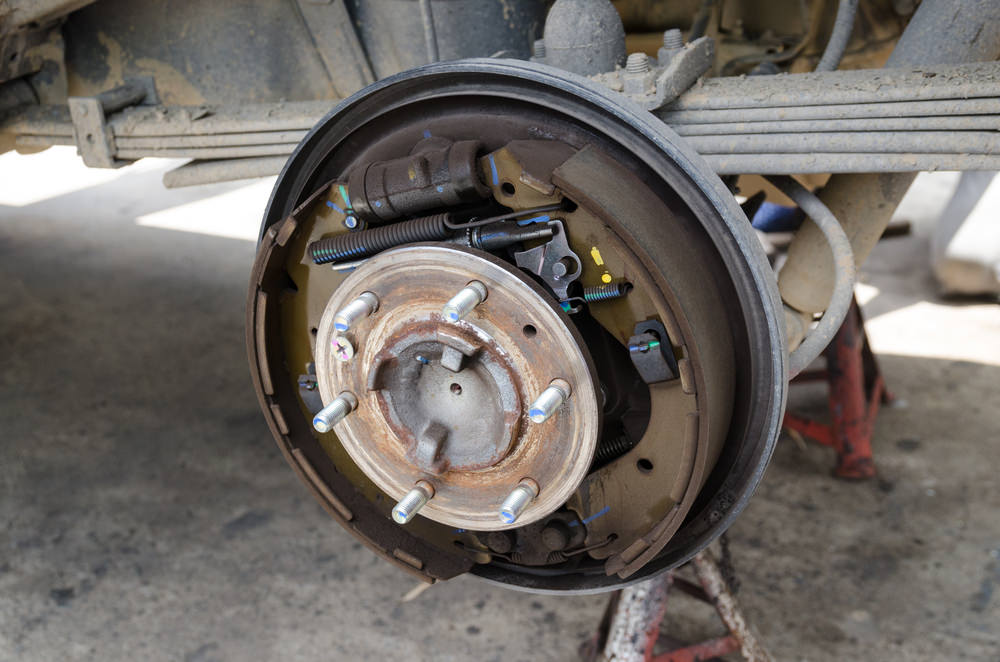
One of the oldest mechanical brakes, drum brakes, have been around for a while. Even though they are less technologically advanced than other brakes on the list, they are still used in cars.
History
The first drum brakes were present in a car made by Maybach in 1990, while the working principle was patented later in 1902 by Louis Renault. Asbestos was used in the first patented drum brake for heat dissipation, while levers, rods and cables were sued to operate the brake mechanically. They had a lot of issues but were still used due to being the most superior option back then.
When Jaguar introduced three cars at Le Mans equipped with disc brakes, drum brakes were in trouble. The three cars won Le Mans due to superior braking capabilities, which started the switch from drum brakes to disc brakes in passenger cars.
Even though newer brakes came and made drum brakes almost obsolete it still finds uses in hand brakes as a disc brake cannot hold a parked car in position. Let’s dive further into drum brakes.
Construction
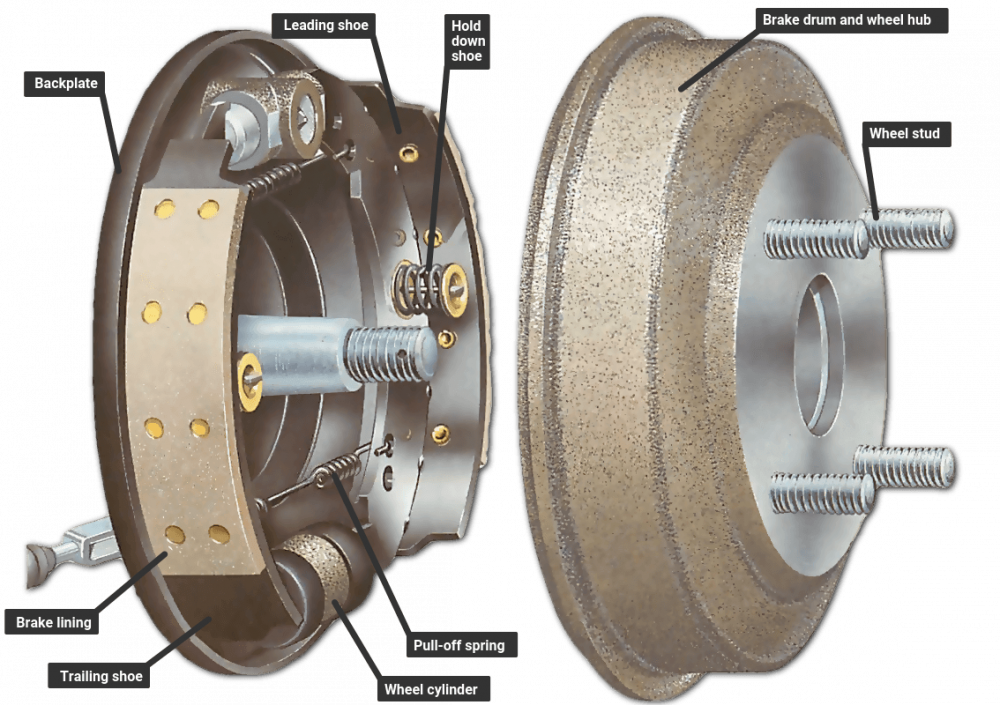
The construction of mechanical drum brakes will be covered in parts as there are a lot of components, and its better to tackle it in this way.
Back Plate
It’s the base of the other components and increases the rigidity of everything else. It is made of strong material as it must withstand the punishment from road debris. As the name suggests, its a place in the back of the system.
Brake Drum
Made of cast iron as it is more heat resistant, the main job of the drum brake is to act as the mediator between the brake lining and the wheels. It rotates with the wheel. It is situated on the wheel hub and acts as the buffer between the brake and the wheel.
Wheel Cylinder
One is present in every brake; it is the hydraulic piston controlling the movement of brake shoes. It is located on the top of the brake assembly.
Brake Shoe
Brake shoes are the reason that a car can stop. Controlled by the wheel cylinder, these brake shoes are on the sides of the brake assembly.
Friction Lining
These friction linings are on top of the brake shoe. They are made up of material that has high heat resistance, high resistance to wear and tear and a high coefficient of friction.
Now that we know how a brake drum is assembled, we can move on to how a brake drum works.
Working
When the brake is applied by the user, hydraulic fluid is pushed into the brake line, and this fluid travels to the wheel cylinder. The wheel cylinder has two pistons that push outwards when the brake fluid enters the cylinder. This, in turn, moves the brake show outwards and towards the brake drum. The brake shoe’s outer side has friction linings that then rub against the brake drum. The friction causes the wheel to slow down as the brake drum is directly attached to the wheel. Due to friction, kinetic energy is converted into heat energy and this causes the car to come to a halt.
That’s it for the working of the drum brake. As we said earlier, it might not be high-tech gear, but it still gets the job done. Now it is only limited to handbrakes, but there is a reason as to why, which we will discuss in the pros and cons section, which coincidently happens to be right below this.
Advantages
- They are easier to maintain.
Remember the rule of thumb. The fewer the number of working parts, the easier it is to maintain something. Being an old piece of technology, drum brakes have the advantage of being easy to maintain. With the right tools, it’s possible to do some part of replacing yourself, but just to be safe, leave the work to the experts! - They are cheap.
Like being easier to maintain, having fewer parts and using basic physics without expanding on anything means the production and manufacturing costs are really low, making it easier to mass-produce. - Compatibility
Drum brakes are compatible with other brakes, like a disc brakes. It doesn’t mean you can use both brakes on the same wheel. Rather use one on the front wheels and the other on the rear. A normal combination is a disc brake on the front wheels and a Drum brake on the rear wheels.
Disadvantages
- It can collect unwanted materials.
Drum brakes have an enclosed design. This means they are almost like a tight container, and it is not easy to escape. It is possible, however, to enter it. Water, dirt, brake gunk and many other things can enter the Drum brake and stay there as being enclosed, and it won’t be able to come out of it. - Heat Build
Another issue with the enclosed design, it’s not easy for air to flow smoothly into the assembly. This causes heat to build up quickly, which results in our next issue. - Easy Wear and Tear
The wear and tear issue is caused by the failure to dissipate heat effectively. This is not the sole reason, though. The brake lining faces a lot of friction which causes it to start wearing fast.
This concludes the Drum brakes. It’s only gonna get better from this point forward. Now towards the second brake system.
Disc Brakes
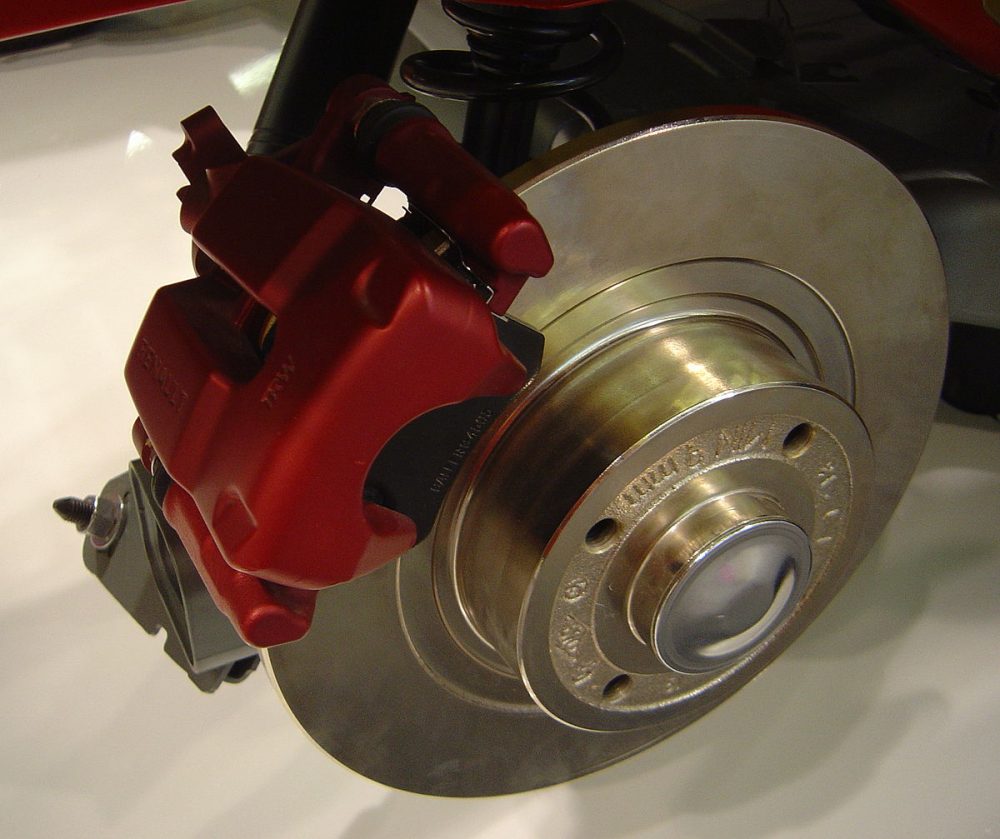
These are brake types that use callipers to slow down a car with friction. Disc brakes are famous and useful and are seen on almost every vehicle nowadays.
Know the difference: Teflon Vs Ceramic Vs Paint Protection Film; Which One Is The Best?
History Of Disc Brakes
The development of disc brakes started with in the 1890s. However, due to lack of good metals that could be used, Frederick Willian Lanchester patented a calliper type disc brake in 1902 that used copper. The roads at that time, however, didn’t allow copper to be used as copper is a soft metal would wear down really quickly. This made the system useless. After multiple people working on various types of the first patented system, the breakthrough came in 1953.
Jaguar launched three cars with disc brake systems in the 24hr race called LeMans. The superior braking system allowed them to win the race. This prompted the companies to employ the disc brakes to consumer cars and thus began the journey of disc brakes.
Construction
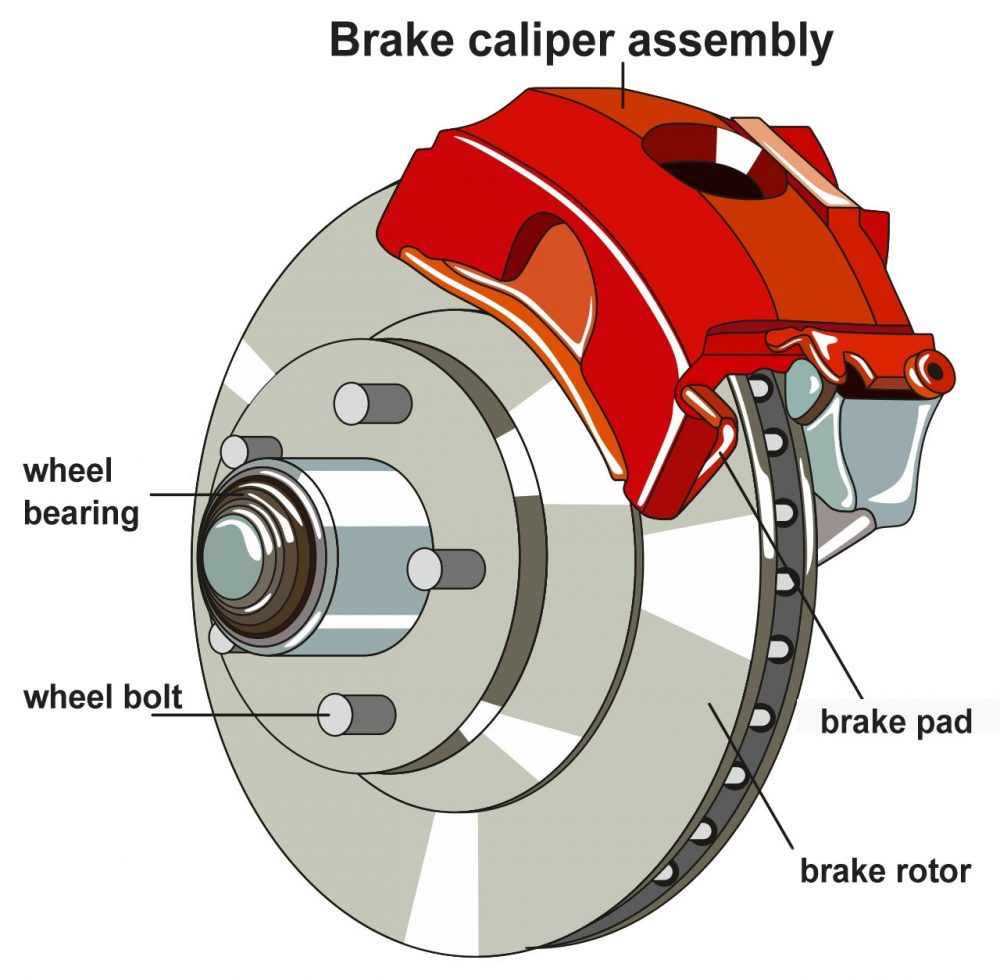
Similar to drum brakes, there are a lot of parts in a disc brake and it makes more sense to tackle these parts separately. The construction will cover the floating type of disc brakes and the second type, and the fixed type will be discussed later.
Subscribe To The GoMechanic YouTube Channel
Rotor
The rotor is the part that is attached directly to the wheel. This rotor rotates with the wheel hence the name. The rotor acts as the connection between the wheel and the brakes.
Pads
Mounted on the brake system, the pads act as friction lining. They are close to the rotor facing outwards and made of durable material with a high friction coefficient.
Calliper
The entire housing of the brake system is called the calliper. It is mounted on the axle and has no direct contact with the rotor until the brake is applied, allowing full and easy movement of the wheels.
Pistons
Inside the calliper’s piston, also called the pot, is the direct connection to the calliper and the brake fluid.
Master Cylinder
The main force behind the braking system. It is placed quite far from the braking system and uses tubes to push hydraulic fluids towards the calliper.
The construction doesn’t end here, as there is important reasoning for where the brake callipers are placed. You might have seen the callipers yourself. They are usually red and are visible on the wheels. Sometimes they are close to the front and sometimes to the back. We will discuss the logic behind every positioning and why they are used. This part needs its subheading as it’s a big topic and quite necessary to learn. It might not sound much, but there are many reasons for their perfect positioning depending on the car and the main use of that car.
Position Of Brake Calipers
Imagine a wheel with 4 different locations. The side towards the car will be called the interior, the top will be called the top, and the bottom will be the bottom. While the front tire’s remaining side will be called outer, and the rear tires remaining side will be called rear. Now let’s discuss the positioning.
-
Weight Distribution
In a car built for high performance, weight distribution is a necessary attribute. The perfect weight distribution means more control over the car at high speeds. To achieve this, the callipers need to be towards the car. This makes the car have a good Moment Of Inertia. A good MOI means the car has a good balance point, and it won’t be easy for the car to roll over.
-
Suspension
The size of the suspension also affects the location of the callipers. Something like a double-wishbone suspension will make it impossible to place the calliper at the top or bottom part of the wheels. This leaves only two positions empty, which will be decided depending on the type of car and which position will help it more.
-
Aerodynamics
Brakes use friction to convert kinetic energy into heat energy. This causes the brakes to overheat. The higher the temperature of a machine, the easier it can get worn down. Thus brakes need a flow of air to keep them cool. Some cars have vents in the front to push the air towards the tires. In such a case, the callipers will be placed in front of the wheels to allow for the air to push into them directly.
-
The Purpose Of The Vehicle
We talked about it a bit in the weight distribution part. The positioning also depends on what the sue for the car is. Something like an offroader will have the calliper placed on top to prevent mud and water from entering the slotted discs. A sports car made for the tracks will have them towards the interior to provide a better MOI. With a car for day-to-day driving, it will be placed in front of the tire to reduce the cost of routing the air from the front towards the back, thus cutting costs.
-
Cosmetic
Callipers can also be placed to appease the eye. Some cars may already have an MOI good enough to manage the callipers to be in any position. In such a case, the position which makes the car look better will be selected. Most callipers that are positioned to look good are placed towards the interior of the car anyways, thus giving both a good look and helping with the Moment Of Inertia.
-
Cost Cutting
Positioning can also help cut costs. A brake callipers towards the interior of the car is good for MOI but is more costly as it requires routing of the air from the front of the car towards the back, which increases complexity and thus causes more money to be spent on it. This is not ideal for cars that are more budget-friendly. The good thing is that these budget-friendly cars are not expected to be high-performing cars anyways, which allows them to use the callipers in front, sacrificing a boost in MOI.
Working
When the brake pedal is pressed down, the working of a disc brake begins. It starts with the pressure from pressing the brake to the master cylinder. The master cylinder then converts this force into hydraulic force by moving fluid along the tubes present in the cylinder. This fluid reaches the pistons and pushes them along. This causes the piston and the entire calliper assembly to move inward. This inward movement causes the entire assembly to clamp down on the rotor, which is directly attached to the wheel axle, thus rotating along with the wheel. Stopping the rotor thus means stopping the wheels, thus bringing the car to a halt.
There is another type of disc brake called the fixed disc brake. The above one that we discussed is a floating type. Let’s talk about fixed disc brakes.
Fixed Disc Brakes
There is only one major difference between floating disc brakes and fixed disc brakes. In fixed disc brakes, the brake calliper doesn’t move. Instead, the side of the calliper which should move has pistons. A fixed disc brake has four disc brakes, unlike a floating disc brake with one. This gives it advantages over the floating type, which we will discuss briefly.
Floating VS Fixed
The major difference is, as we have already discussed, the number of pistons. Having more pistons and the structure staying ‘fixed’ gives the fixed disc brakes more stability over floating. This also makes it so that the fixed disc brake effect is evenly applied to the entire rotor, unlike floating disc brakes.
This doesn’t make floating disc brakes any bad, either. Floating disc brakes are still ideal for day-to-day usage as it gets the job done and cost less than fixed disc brakes. Fixed disc brakes are only useful in high-performance cars where having the car cost more due to the fixed disc braking system doesn’t matter.
Let’s get into the advantage and disadvantages of disc brakes. We are considering both types of disc brakes as one entity for the pros and cons. The advantages and disadvantages will be in comparison against drum brakes.
Advantages of Disc Brakes
- More Power
Disc brakes have a really high stopping power compared to something like a drum brake which helps in slowing down a high-speed car or helping a car stop as fast as possible. - No Heat
Disc brakes are made in such a way that they get constant airflow. Due to being slotted and not a closed structure like drum brakes, they dissipate heat fairly easily and thus don’t overheat. The worst case scenario of overheating can cause tire blowouts which can mortally injure. - No Water Retention
Due to not being an enclosed chamber, the disc brake doesn’t store water in them, and it flows right off. This is completely different from a drum brake which can hold water and cause really fast wear and tear. - Safer During Hard Braking
Unlike drum brakes that can lock up during hard braking, disc brakes don’t lock up. Hard braking is when a lot of force is applied on the brake pedal to make the vehicle stop as fast as possible. This can cause the drum brake to lock up, which in turn removes any control from the driver’s hand, making the car skid. Disc brakes don’t suffer from this. However, both brakes use an Anti-Lock Brake System to prevent this. We will talk about this later in the blog.
Disadvantages
- Money
Disc brakes cost much more than a drum brake would. This is due to being more advanced and more complex.
- Tough Maintenace
Being a complex piece of hardware disc brake requires more work to maintain and more skill to repair. This, in turn, means they are costly to get repaired. The complexity comes from the number of parts involved, which increases the amount of work needed to fix the system. - Air Troubles
If any amount of air enters the master cylinder or the tubes with the hydraulic fluid, the brake will instantly fail. This is a serious issue and thus needs utmost care during activities like bleeding the brake fluid and other maintenance.
With both types of brakes discussed, we can move on to the safety systems and how they help protect the passengers in a car.
Safety And Control Systems
Safety systems are to a car what snacks are to a human. You can make it work without them, but why. Yes, I know the analogy was bad, but that’s all you are getting onwards to safety systems!
Present in every modern car safety system is an integral part of an automobile. They ensure a safe drive and help protect in case of an accident, reducing injury during an accident.
They are of two types, Active and Passive. Active systems are ones that always in work to prevent accidents, while passive triggers under special conditions, such as an occurrence of an accident.
Almost all of the active safety systems also help in the control of the car. As such, the topics are covered together.
Must Read: Pedestrian Safety and Protection Norms, A Step Towards Safer Roads?
Active Safety Systems
Systems that are actively looking out for us and preventing accidents are active safety systems. Safety systems majorly constitute active safety systems. We will briefly go through all of the active safety systems. Starting with CMBS.
Collision Mitigation Systems/ Adaptive Cruise Control

Considered to be the one small step for the automobile industry, a giant leap for autonomous cars, CMS or Collision MitigationSystem is one of the best active safety systems. It can detect oncoming cars and prevent rear-end collisions and, in worst-case scenarios, mitigate the damage that it might cause.
Adaptive Cruise Control is a feature that uses CMS to work, so we thought to cover both of them together and prevent filler content.
Parts Involved In CMS
There are two major parts needed in CMS. A millimetre wave radar and a camera. The rest of the parts are already present in a car, like an ECU, to use the data provided by the radar and the camera.
The millimetre radar is called such due to the range of the electromagnetic wave it reads. There are 7 waves in a spectrum, and the millimetre radar can interpret one of them, which is the microwave range. The microwave range is what allows it to see the distance of an object. The wavelength of the microwave is between 1mm to 10mm hence the radar gets the name millimetre radar.
How these two sensors work together is explained below.
Working Of CMS Sensors
The issue with a millimetre radar is that it can easily measure the distance between any object, but it reflects off of any metal surface. This means it can assume that a signboard on the side of a road is a car and apply the brakes. To prevent this, a normal camera is used. There are two of these cameras. One is mounted on the back of the internal rearview mirror, and the other is on the dashboard. However, the problem with a camera is that it is bad at judging distance. It all clicks now, doesn’t it? The camera distinguishes types of objects while the millimetre radar judges the distance.
This covers the internal working of the CMS, but how does it actually help mitigate accidents? Read the steps below.
Functioning OF CMS
Now that we are familiar with how the sensors work, we can go into what a CMS does and what the steps are. The case assumes the car is approaching another car from the rear at an undesirable speed and shows no sign of the driver applying brakes.
-
Warning the driver
The CMS will inform the driver about a possible accident through the use of stimuli. A display on the infotainment system, along with audio, will be provided to grab the attention of the driver. The next step occurs if the drivers fail to respond by applying brakes or slowing down the speed manually.
-
Light Braking
The CMS still tries to warn the driver about the imminent collision but, this time, takes the braking into its own hands. The CMS now applies light braking to slow down the car and avoid an accident. If the light braking isn’t enough and the driver is still not responding, it goes to the final step of the CMS.
-
Hard Braking
The system now assumes it’s close to impossible for the driver to act and prevent the accident, so it applies hard braking to either mitigate the collision completely or reduce the damage caused by the accident by slowing down as much as possible.
Adaptive Cruise Control
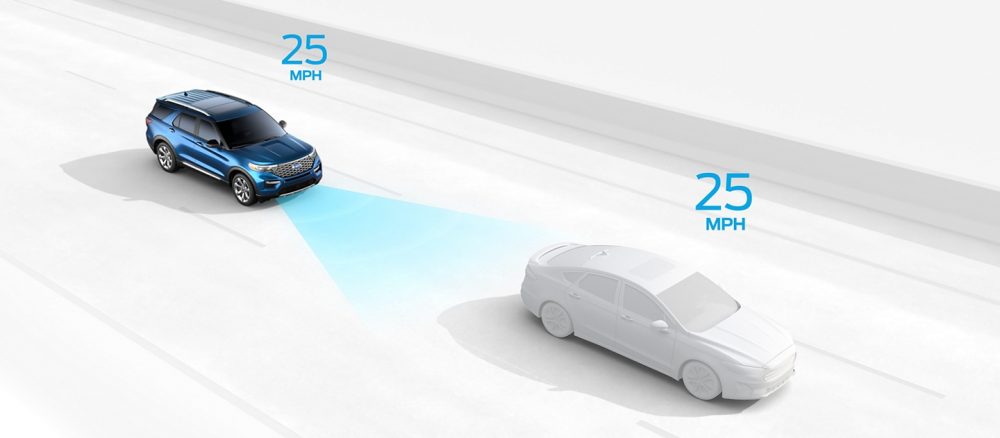
The system sets the car speeds at a desirable range you want to cruise at. The difference from normal cruise control is that it uses CMS to prevent collisions and avoid accidents. It can automatically reduce its speed according to the needs, unlike a normal cruise control where you have to actively control speed in case of a car in front of you to prevent rear-end collisions.
The driver is prompted to put two speeds, the maximum speed the car should drive at and the lowest speed the car should be at. The Adaptive cruise control will then keep the car in this range depending on the traffic on in front of the car. It also keeps a lookout for lane-switching cars but has no control over cars behind and the steering wheel. So it’s car automation but no steering control.
Braking seems like an easy enough job, right? Press the pedal, and the brake is applied. Why would we need an assist system to help with the braking? There are many reasons for this, and we will cover those reasons along with the system that helps overcome those reasons. These also come under active safety systems.
Anti-Lock Braking System
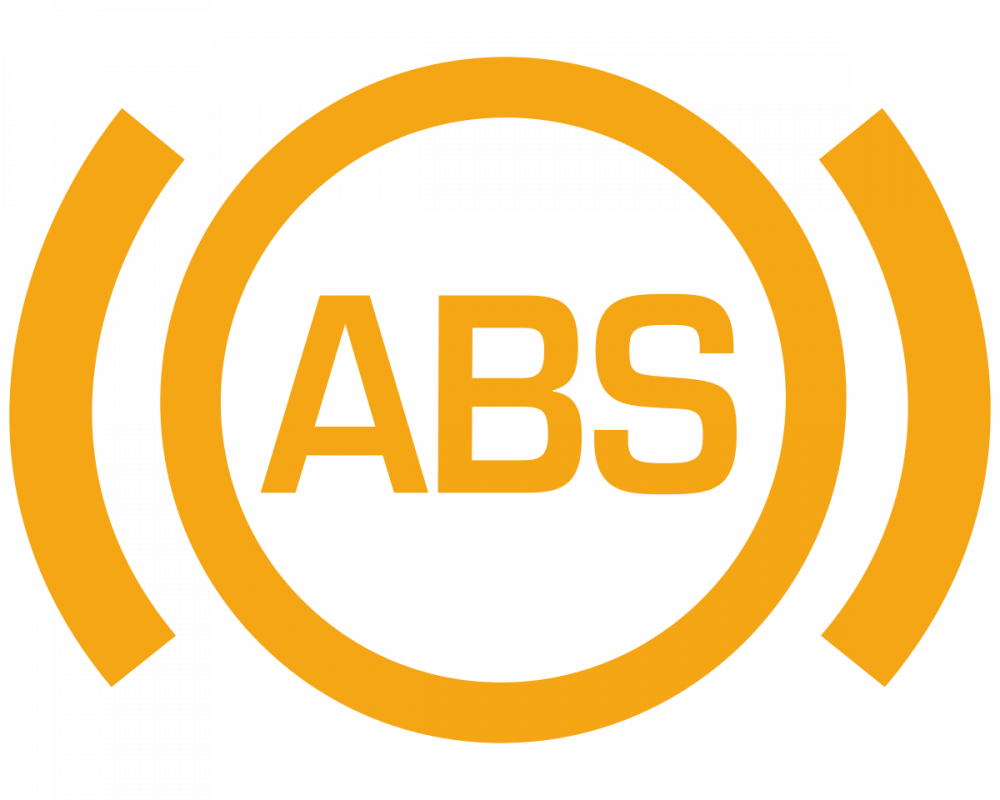
The use of an antilock braking system is almost a necessity now. Even low-end cars can reach high speeds wheel locking is a common phenomenon. Wheel locking is when you apply hard brakes. The car brakes lock the wheel in place to stop the speed; this, in turn, makes the wheel impossible to move with the steering wheel, which causes an accident. As it actively participates to prevent in preventing car crashes, it is an Active Safety System. How does it overcome the issue caused by the normal brakes? Read below.
Working On An Anti Lock Braking system
In a normal braking system, the brake pedal is pressed, the brake is applied, and that’s it. Nothing is over the top or complex, as we have explained above about it. However, ABS is a whole new thing and is complex compared to a normal braking system.
Each wheel has speed sensors; the job of these speed sensors is to note any discrepancies. In case of a wheel lock due to hard braking, the speed of the tire will almost instantly drop. This is a discrepancy that the sensor will pick up. All of this works in mere milliseconds, so it’s almost impossible for humans to react to something like this. The sensors send this data to the ECU, prompting the use of ABS.
ABS fluctuates the brakes. This means that the brakes are applied for a second, then let go. It basically applies brakes and leaves the pedal almost instantly. As we said, all of this happens in 100th of a second, so we can’t even comprehend what is happening. To know if the car is using ABS when you hard brake, you’ll be able to feel pulsing on the brake pedal.
The fluctuating is done by controlling the brakes through valves. The ECU controls the flow of brake fluid, thus controlling the movement of brakes. This allows the brake not to jam the wheel, thus offering full control over the steering system.
Along with working with an ABS, we saw the advantages of it; now we see the disadvantages.
Disadvantages Of ABS
ABS has two disadvantages. One is mechanical; the other is driver error. The mechanical one is that ABS increases brake distance if a car doesn’t have good friction. Wet roads or black ice roads will significantly increase braking distance; ABS however still allows for complete car control.
The second disadvantage is the false sense of security. People that don’t have a lot of knowledge about the working of ABS think that it is some miracle product that will somehow make the car never fail in braking, but as we discussed above, the slippery surface will cause a major issue if a person doesn’t count for it during braking.
Next in active safety systems is the Traction Control System (TCS). It’s a less complex system and doesn’t need that much understanding.
Traction Control System
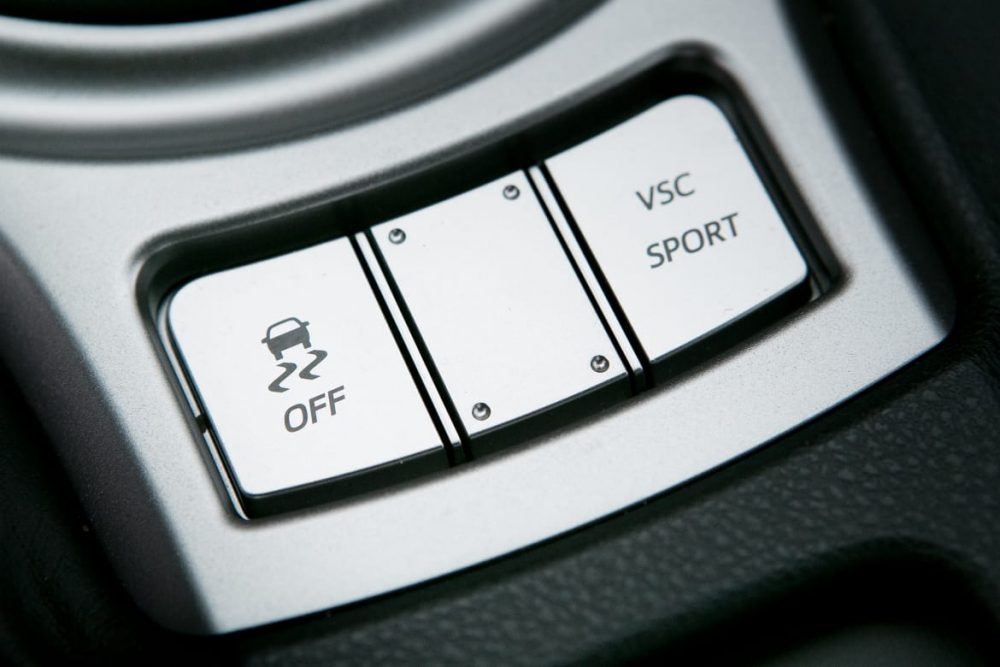
One of the easier ones to understand. There isn’t much going on here, so subheadings aren’t needed. The job of TCS is to ensure the tires don’t slip during acceleration. It uses the same sensors as ABS. The sensors compare the speed of the tire and the speed of the car. If the speed of the tire is faster than the car, it means the tire is skidding. When this occurs, there are two things the TCS can do: apply the brake to make the wheel reach car speed or cut off power. Using one of these methods, TCS can bring the car to a stop and ensure the car doesn’t slip.
As we said, this isn’t as complex as something like an ABS, but it is an active control system, so we need to talk about it.
Next up is the Electronic Stability Control. Another important safety and control system, this one, isn’t any complex either.
Electronic Stability Control
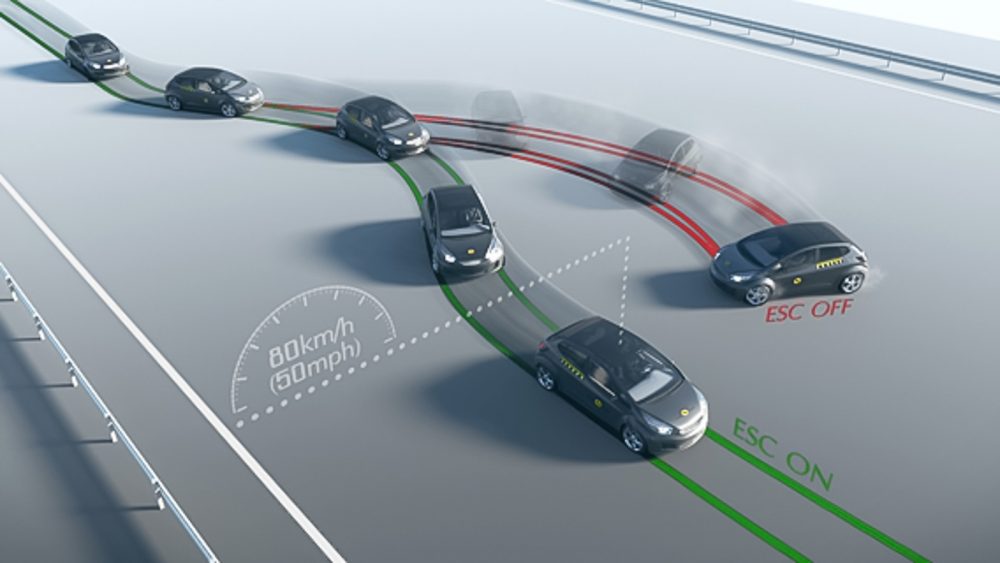
When you take a turn, the ESC or its commonly known name Electronic Stability Program calculates the path you will take a turn in by using sensors to see the movement of the steering wheels. When it notes that the car will take a wider turn than it should it applies brakes to the inner tires. Inner being the tire towards the run. If it’s a right turn, the right side wheels are inner. This brain causes the tire to become a pivot point causing the entire car to move with respect to it. You might have seen this happen in movies involving ships where the anchor is used to halt the ship and turn it almost instantly.
That’s the working of ESP, simple yet lifesaving. And with this, we have covered all of the Active Safety Systems. Onwards to Passive Safety ones. Do note that they are fairly easy to understand, and you probably know most of them anyway.
Passive Safety System
The safety systems that trigger after an accident occurs are passive safety systems hence the name. Being fairly simple, these can’t be scoffed at. These will determine life-and-death scenarios by their effectiveness. We will discuss two of them, seatbelts and airbags. As we said, you might know most of these anyways.
Seatbelts
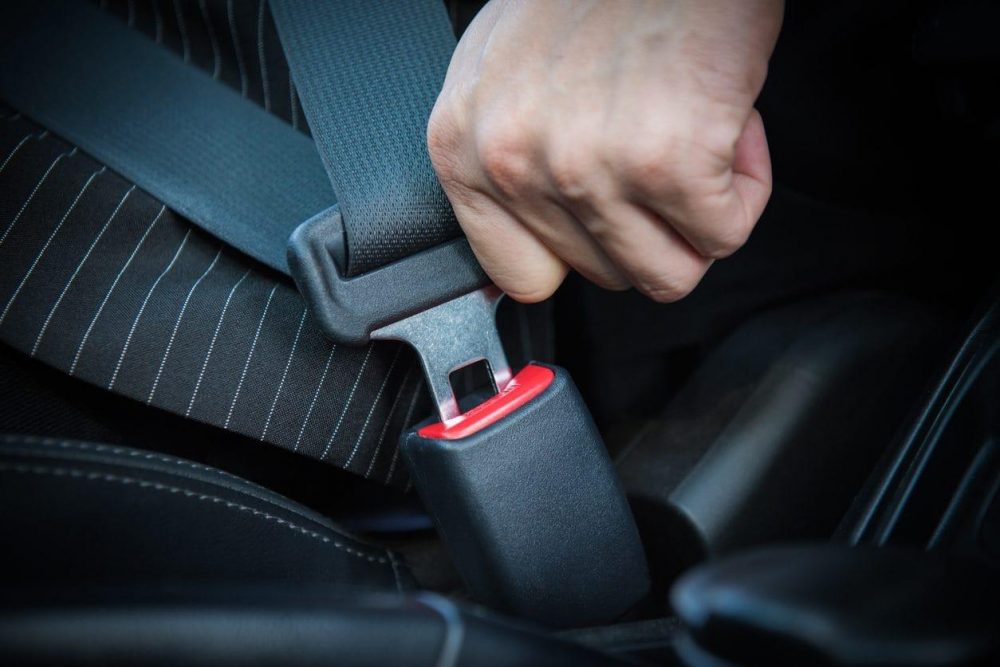
Pretty sure a refresher is not needed for this, but there are some things they do that is unknown. The main job of the seatbelt is to ensure the people wearing it stays secured in their seats for other systems to work effectively. Airbags are only good when you collide with them head-on, not when you are thrown out of the windshield because you didn’t wear the seatbelt. They use sensors employed by airbags ( which we will explain in the Airbags topic) to prepare for an accident. When a collision occurs, the seatbelt tightens automatically and braces the person for impact.
Airbags

These are not complex at all, either. The car has sensors all around it which actively look for deformation of the car, signalling that the car is undergoing a collision. This allows the airbags to deploy and cushion the blow. The air inside airbags is nitrogen. This happens due to a chemical reaction that takes place instantaneously. After a collision, airbags deploy within 0.25 seconds. The side airbags are even faster, and the expansion can reach speeds up to 750+ km/hr. YES, it’s that fast!
This covers the airbags and, with it, the passive safety system.
And That’s It!
We hope the blog post helped you understand the Brakes, Safety, and Control Systems of your car and how they actively and passively manage your car, ensuring you have a smooth and safe ride.
Next week we will discuss something else which will be related to the automotive industry, so stay tuned!
Have a read: Automobile Suspension (Car Suspension) Explained






[…] Image Source :- tiremaxx, gomechanic […]